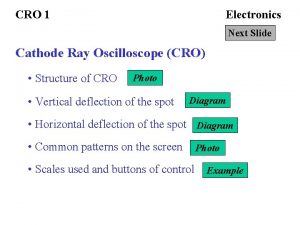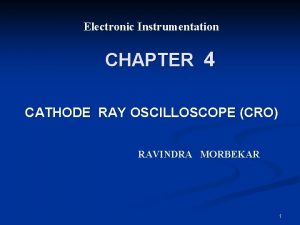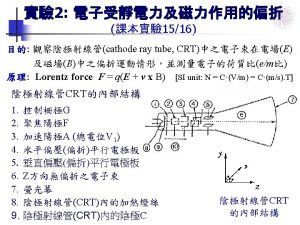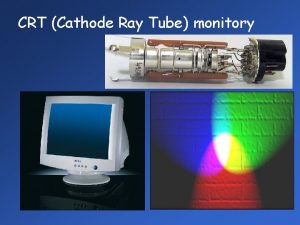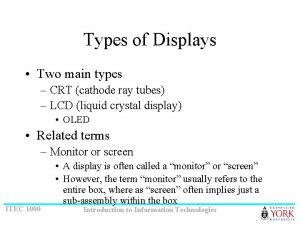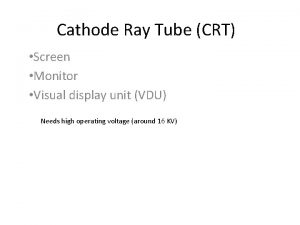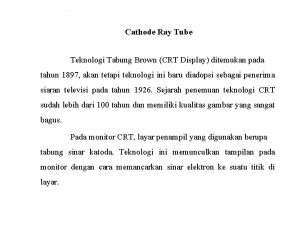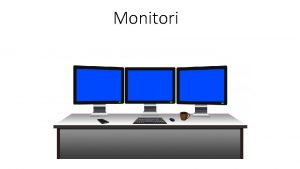Types of monitors n CRT n Cathode Ray












- Slides: 12

Types of monitors n CRT n Cathode Ray Tube n LCD n Liquid Crystal Display

CRT n The filaments at the back of the cathode tube shoot a beam of electrons to the screen at the front of the tube n This screen is coated with phosphor that glows when struck by the electron beam.

LCD n An LCD panel produces an image using a liquid crystal material made of large, easily polarized molecules

Features of a monitor

Video cards n Interface between the monitor and the computer. n Also called graphic adapters, video boards, graphics cards, or display cards. n Sometimes the video controller with a video port is integrated into the motherboard.

Video card

Methods of data transfer n RGB video port n standard method of passing three separate signals for red, green, and blue which most video cards and CRT monitors use. n uses a regular 15 -pin Super VGA port

Methods of data transfer n DVI port - Digital Visual Interface port n digital interface standard used by digital monitor such as a digital flat panel monitor, and digital TVs (HDTV). n for a video card that only has a DVI port, you can purchase a VGA converter so you can connect a standard VGA cable to use a regular analog monitor.

Methods of data transfer n S-Video – Super Video n this method sends two signals over the cable, one for color and the other for brightness, and is used by some high end TVs and video equipments. n it uses a 4 -pin round port

Flat Screen Monitors LCD - Plasma n Picture Quality Normal computing, both LCD and plasma screens will provide sharp and clear display n Watching Blu-Ray movies or playing highdefinition games, Plasma screens have less picture lag and sharper color resolution than LCD displays. n

LCD - Plasma n Power Usage n LCDs use considerably less power than plasma displays, which use self-lighting pixels n Screen Burn-In n Plasma screens are more likely to experience screen burn-in (the screen becomes permanently discolored where the unchanging image was)

LCD - Plasma n Pixel Levels n LCD screens generally have more pixels per square inch than plasma n makes them ideal if you are working with complex spreadsheet programs or editing software n Size n Plasma monitors are usually ahead of the curve regarding their maximum size n the biggest monitors are plasma
 Cathode ray oscilloscope working principle
Cathode ray oscilloscope working principle Cathode ray oscilloscope symbol
Cathode ray oscilloscope symbol Diagram of cathode ray tube
Diagram of cathode ray tube Dr. vaibhav shah
Dr. vaibhav shah Cathode ray tube tracker
Cathode ray tube tracker Cathode-ray tube
Cathode-ray tube What is cro in electronics
What is cro in electronics Cathode ray oscilloscope function
Cathode ray oscilloscope function Goldstein cathode ray tube
Goldstein cathode ray tube Crts ryles tube full form
Crts ryles tube full form Crt l
Crt l Cathode ray oscilloscope animation
Cathode ray oscilloscope animation Cro formula
Cro formula

